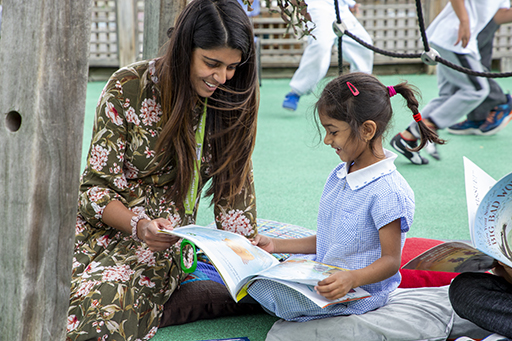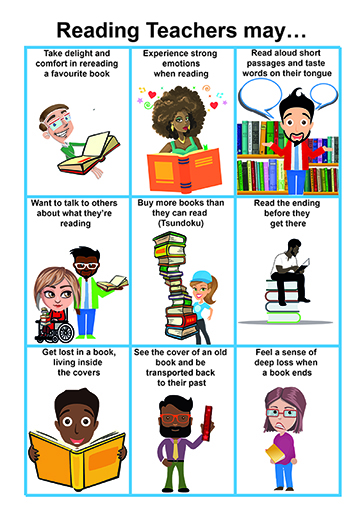2 Reading Teachers
Reading Teachers are teachers who read and readers who teach, and who explore the interesting and potentially fruitful connections between these two stances. These reflective professionals hold a mirror up to their own everyday reading practices, preferences and habits and reflect on what it means to be a reader. They seek to understand more about reading in order to support their children as readers. They also frame their classroom practice in responsive ways that recognise diversity, desire and difference. So, Reading Teachers do far more than simply share a positive attitude towards reading.

The idea of Reading Teachers was originally coined by an American research team (Commeyras et al., 2003) and has been further researched and developed in UK classrooms (Cremin et al., 2014; Cremin et al., 2018; Cremin, Williams and Denby, 2019). The work shows that Reading Teachers are well positioned to develop genuinely shared reading communities, to influence children’s perception of themselves as readers and, significantly, to impact upon young people’s engagement as readers.
Activity 2 Developing as a Reading Teacher
- Notice: Take a look at Figure 1. Make a note of all the reading habits and practices you recognise or may engage in sometimes.
- Document: Are there any more you can add? For example, you may turn down pages, make notes in the margin, be oblivious to all else while reading, skip long passages, etc.
- Reflect: Select one of your habits and consider what it might mean for child readers. For example, if you can relate to seeing the cover of an old book and being transported back to a time in your past, might children value being re-connected to their past reading lives in the same way?
- Act: Plan to undertake an activity or discussion in school to build on what you have noticed. For example, to explore being ‘transported back’ could you borrow picture books from a younger class to browse and re-read? Or might you invite the class to create PowerPoints of their reading histories to share and consider their earlier engagement? Could this help give some children a stronger sense of identity as readers, even a shared identity?
Comment
Such activities, based on the behaviours and habits of reflective adult readers, bring an authenticity to reading experiences and help to build communities of readers. The action taken will be adjusted according to the age of the children, but even when doing this activity with six-year-olds, you are likely to find that re-reading their favourite books from nursery is an engaging, collaborative experience for them.
Nonetheless, challenges exist for teachers who wish to teach from a reader’s point of view, especially in countries where the standards agenda and reading proficiency take centre stage, and reader relationships and Reading for Pleasure are positioned backstage. In spite of this, by becoming more aware of your own and the children’s identities as readers, you will begin to recognise diversity and difference and take responsibility for shaping what counts as reading in your classroom.
In the next section you’ll watch a Reading Teacher in action and see what she did to support her class to become motivated and engaged readers.

